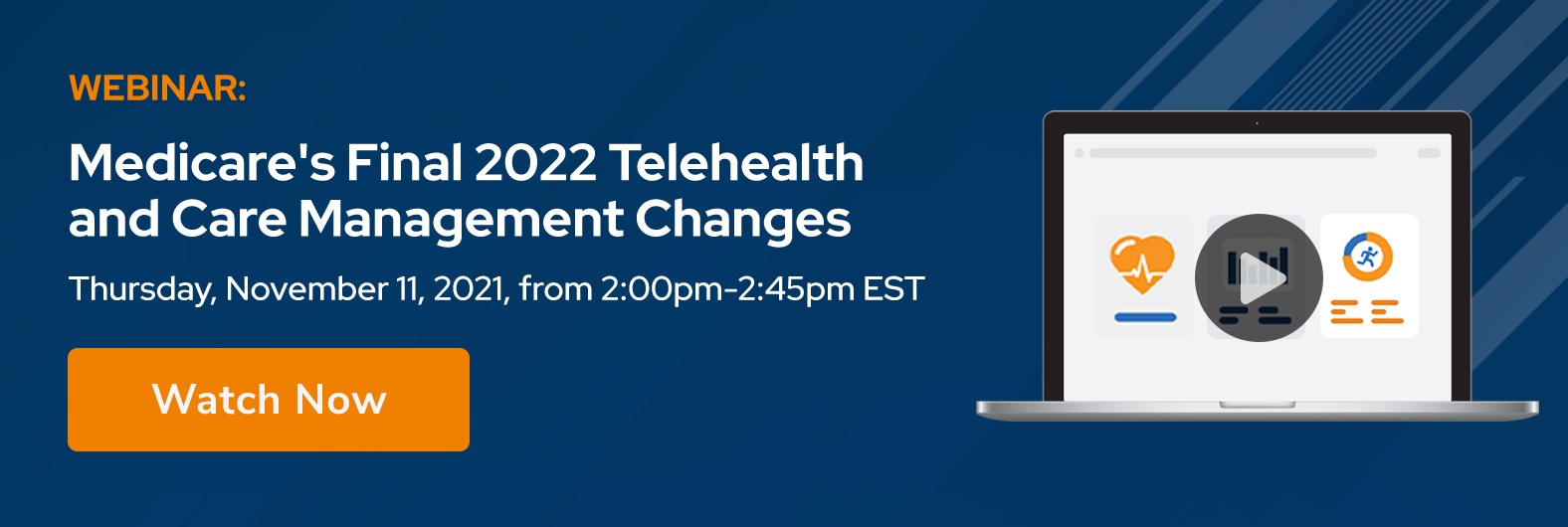Update: The story below provided a brief overview of this breaking news. As of 2022, the information remains accurate. If you are interested in learning about noteworthy changes for 2022, view an on-demand webinar here.
The Centers for Medicare & Medicaid Services (CMS) has released its 2021 Medicare physician fee schedule final rule, which includes many noteworthy changes to remote patient/physiological monitoring (RPM) and the provision of other remote services.
Summarized below are key takeaways from the final rule. We have organized this summary by topic and then broken each down by sharing the changes that were included in the August proposed rule and how the final rule affects those changes.
Definition of Interactive Communication
Proposed Rule:
- Clarify that for CPT 99457 and CPT 99458, an "interactive communication" is defined as a conversation occurring in real-time that includes synchronous, two-way interactions that can be enhanced with video or other kinds of data (as described by HCPCS code G2012). Note: If finalized, this rule would no longer include the usage of text messaging — a communication mechanism relied upon by many remote patient monitoring and chronic care management platforms — in the billable definition of interactive communication. This means that time spent messaging patients, even when in real-time, would not be countable towards RPM care management time.
Final Rule:
- The rule itself reaffirms that they expect 20 minutes of interactive communication and keeps the same definition as the proposed rule.
- A fact sheet issued by CMS concerning the final rule seems to contradict itself and the final rule:
- "We clarified that for CPT codes 99457 and 99458, an 'interactive communication' is a conversation that occurs in real-time and includes synchronous, two-way interactions that can be enhanced with video or other kinds of data as described by HCPCS code G2012. We further clarified that the 20-minutes of time required to bill for the services of CPT codes 99457 and 99458 can include time for furnishing care management services as well as for the required interactive communication."
Device Requirements
Proposed Rule:
- Clarify that the medical device supplied to a patient as part of CPT code 99454 must:
- meet the definition of a medical device per Section 201(h) of the Food, Drug, and Cosmetic Act;
- be reliable and valid; and
- electronically (i.e., automatically) collect and transmit a patient's physiologic data rather than permit patients to self-report or self-collect data. Note: During the PHE, some patients have used smartphones to take pictures of device readings and submitted them to the practice. This and other mechanisms of self-recording data would no longer be acceptable.
Final Rule:
- All Confirmed
Established Patient Requirement
Proposed Rule:
- Following the COVID-19 public health emergency (PHE), CMS will again require that an established patient-physician relationship exist for the furnishing of RPM.
Final Rule:
- Despite significant pushback, CMS is reinstituting the requirement following the PHE.
Consent Obtainable At Time of Service
Proposed Rule:
- For calendar year (CY) 2021, establish permanent policy to allow consent to be obtained at the time that RPM services are furnished.
Final Rule:
- Confirmed
Furnishing of Services By Auxiliary Personnel
Proposed Rule:
- For CY 2021, establish permanent policy to allow auxiliary personnel to furnish RPM CPT codes 99453 and 99454 services under a physician's supervision, with auxiliary personnel
Final Rule:
- Confirmed
Furnishing of Services Only By Providers
Proposed Rule:
- Clarify that only physicians and non-physician practitioners who are eligible to furnish E/M services (CPT codes 99453, 99454, 99091, 99457, and 99458) may bill remote patient monitoring services.
Final Rule:
- Confirmed
Patients With Acute and Chronic Conditions
Proposed Rule:
- Clarify that practitioners may furnish RPM services to patients with acute conditions as well as patients with chronic conditions.
Final Rule:
- Confirmed
Required Measurement-Days to Bill for RPM
Proposed Rule:
- Clarify that after the PHE, CMS will maintain the current requirement that 16 days of data each 30 days must be collected and transmitted to meet the requirements to bill CPT codes 99453 and 99454.
Final Rule:
- Confirmed the 16 days.
- The aforementioned fact sheet talks about the current two-day requirement and how it expires after the PHE ends without mentioning that this requirement only applies to suspected or confirmed COVID-19 patients. (It is important to note that the current two-day requirement only applies to patients who have a suspected or confirmed case of COVID-19.)
- CMS also stated that while it asked for clinical examples of when a lower amount of required days would be needed, all it received were people positing the idea of lowering the number of days from 16 to six without providing the requested clinical scenarios.
Designation of Medical Device(s) as a Practice Expense
Proposed Rule:
- Clarify that for CPT code 99454, the medical device or devices supplied to the patient and used to collect data are considered equipment incorporated into 99454's reimbursement and are thus direct practice expenses. This proposal seems to suggest that, since devices are included in 99454, practices cannot push the costs of devices onto the patient or receive reimbursement for devices by billing them as durable medical equipment.
Final Rule:
- "CPT code 99454 is valued to include the medical device or devices supplied to the patient and the programming of the medical device for repeated monitoring. We reviewed the PE inputs for CPT code 99454 in the proposed rule and clarified that the medical devices that are supplied to the patient and used to collect physiologic data are considered equipment and, as such, are direct PE inputs for the code."
- Interpretation: RPM providers might be permitted to charge patients for the devices by following the rules for charging past the Medicare rate, but providers cannot bill the devices to Medicare outside of CPT 99454. This part of the final rule is particularly vague. We expect there to be more guidance provided on what this means prior to the rules going into effect.
Additional Remote Physiological Final Rule Developments
The final rule included some noteworthy developments that were not referenced in the proposed rule.
16 Measurement-Day Requirement and Initial Training Code
Final Rule:
- CMS "reviewed the CPT prefatory language" of the two practice expense-only codes (CPT 99453 and CPT 99454) and is interpreting the initial training code (CPT 99453) to include the 16 measurements per 30 day-period requirement that is included in the description of CPT 99454.
- As CMS states, "This language suggests that even when multiple medical devices are provided to a patient, the services associated with all the medical devices can be billed only once per patient per 30-day period and only when at least 16 days of data have been collected."
- Interpretation: CMS chooses to use the word "suggest" here, which is vague, but if taken at face value, this would seem to mean that RPM providers can no longer bill for the initial training code unless there are 16 measurements completed in the 30 days following the initial training. We are unsure if CMS will clarify how it worded this to reaffirm the 16-measurement rule is only for CPT 99454.
Billing CPT 99091 Concurrently With the Newer Codes
Final Rule:
- CMS states the following: "Commenters disagreed with our suggestion that CPT codes 99091 and 99457 can be billed together. Commenters reported that these two codes are incompatible and cannot be reported in the same calendar month or in conjunction with one another"We continue to believe that, if reasonable and necessary, CPT codes 99091 (collection & interpretation physiologic data) and 99457 (remote physiologic monitoring treatment management), given their descriptions of services in the CPT Codebook, could be reported for the same patient. We believe the two codes, as currently described, provide different types of services."
"We remind readers that the valuation for CPT code 99091 includes a total time of 40 minutes of physician or non-physician practitioner work broken down as follows: 5 minutes of pre-service work (for example, chart review); 30 minutes of intra-service work (for example, data analysis and interpretation, report based upon the physiologic data, as well as a possible phone call to the patient); and 5 minutes of post-service work (that is, chart documentation). We believe that in some instances when complex data are collected, more time devoted exclusively to data analysis and interpretation by a physician or NPP may be necessary such that the criteria could be met to bill for both CPT codes 99091 and 99457 within a 30-day period."
Interpretation: Up until this rule, it has been widely believed within the industry that the old provider-specific CPT 99091 code was not billable at the same time as CPT 99457. This new interpretation basically allows providers to bill for "complex" RPM management when the provider has to spend significant time managing the patient and their RPM care plan. Further, this code (CPT 99091) can be billed each 30 days whenever that complex management occurs without affecting the practice's ability to bill clinical staff time via CPT 99457 each calendar month.
Reminder: For a more in-depth discussion and analysis concerning these and other developments from the final rule, register for our upcoming webinar here.


